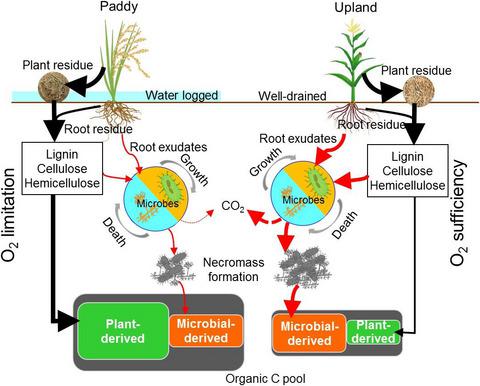当前位置:
X-MOL 学术
›
Glob. Change Biol.
›
论文详情
Our official English website, www.x-mol.net, welcomes your
feedback! (Note: you will need to create a separate account there.)
Contrasting pathways of carbon sequestration in paddy and upland soils
Global Change Biology ( IF 10.8 ) Pub Date : 2021-03-13 , DOI: 10.1111/gcb.15595 Xiangbi Chen 1, 2 , Yajun Hu 1 , Yinhang Xia 1, 2 , Shengmeng Zheng 1 , Chong Ma 1 , Yichao Rui 3 , Hongbo He 4 , Daoyou Huang 1 , Zhenhua Zhang 2 , Tida Ge 1 , Jinshui Wu 1 , Georg Guggenberger 5 , Yakov Kuzyakov 6, 7 , Yirong Su 1
Global Change Biology ( IF 10.8 ) Pub Date : 2021-03-13 , DOI: 10.1111/gcb.15595 Xiangbi Chen 1, 2 , Yajun Hu 1 , Yinhang Xia 1, 2 , Shengmeng Zheng 1 , Chong Ma 1 , Yichao Rui 3 , Hongbo He 4 , Daoyou Huang 1 , Zhenhua Zhang 2 , Tida Ge 1 , Jinshui Wu 1 , Georg Guggenberger 5 , Yakov Kuzyakov 6, 7 , Yirong Su 1
Affiliation

|
Paddy soils make up the largest anthropogenic wetlands on earth, and are characterized by a prominent potential for organic carbon (C) sequestration. By quantifying the plant‐ and microbial‐derived C in soils across four climate zones, we identified that organic C accrual is achieved via contrasting pathways in paddy and upland soils. Paddies are 39%–127% more efficient in soil organic C (SOC) sequestration than their adjacent upland counterparts, with greater differences in warmer than cooler climates. Upland soils are more replenished by microbial‐derived C, whereas paddy soils are enriched with a greater proportion of plant‐derived C, because of the retarded microbial decomposition under anaerobic conditions induced by the flooding of paddies. Under both land‐use types, the maximal contribution of plant residues to SOC is at intermediate mean annual temperature (15–20°C), neutral soil (pH~7.3), and low clay/sand ratio. By contrast, high temperature (~24°C), low soil pH (~5), and large clay/sand ratio are favorable for strengthening the contribution of microbial necromass. The greater contribution of microbial necromass to SOC in waterlogged paddies in warmer climates is likely due to the fast anabolism from bacteria, whereas fungi are unlikely to be involved as they are aerobic. In the scenario of land‐use conversion from paddy to upland, a total of 504 Tg C may be lost as CO2 from paddy soils (0–15 cm) solely in eastern China, with 90% released from the less protected plant‐derived C. Hence, preserving paddy systems and other anthropogenic wetlands and increasing their C storage through sustainable management are critical for maintaining global soil C stock and mitigating climate change.
更新日期:2021-05-08































 京公网安备 11010802027423号
京公网安备 11010802027423号